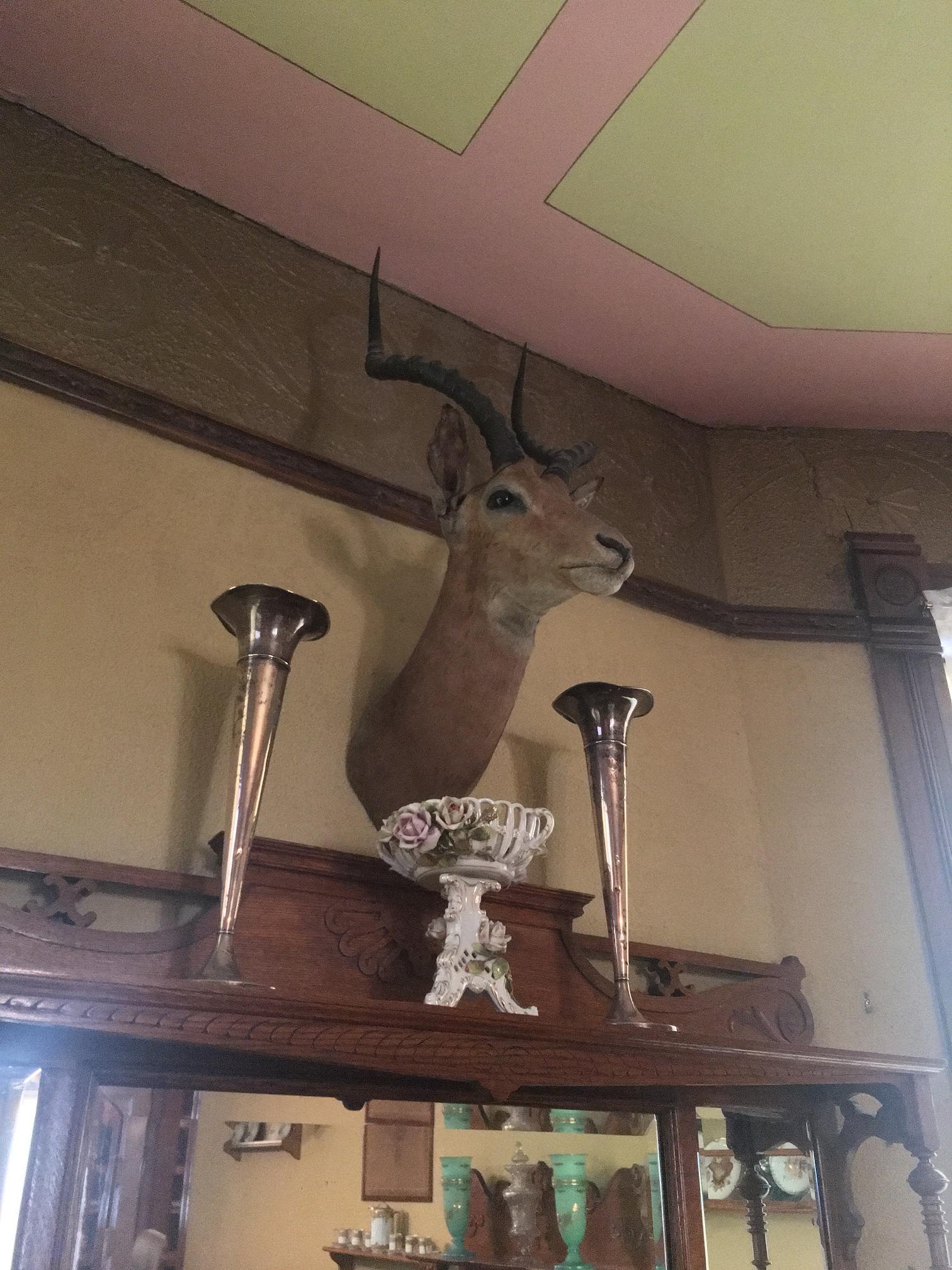The Molly Brown House Museum is no stranger to dead animals- they perch atop furniture; lay upon the ground, and hangout on the dining room walls. Margaret Brown was known around Denver as a generous benefactor of the community and its inhabitants. She was the type of woman who used her voice to help the voiceless. In 1910 she donated enough money for the creation and subsequent running of the Denver Dumb Friends League, a no kill animal shelter still active today. So why is it, that if Margaret loved animals so much, she would decorate her home with the pelts and heads of them?
To answer this question, we must first understand the familial space as a form of expression during the Victorian Era. The home reflected much more about a family than just the space in which they lived; it was considered a form or mode to illustrate one’s beliefs and understandings of the outside world. The formal parlour was the most important feature in Victorian middle and upper class homes, for this reason. By the 1850s, upper crust society dictated that parlours were to be used for important social gatherings, such as teas, parties and funerals. It was fundamental that a family’s parlour would reflect their cosmopolitan outlook on life; portraying a sense of gentility, or refined taste, through their decorations and belongings in the house, to be viewed and consumed by the outside world[i].
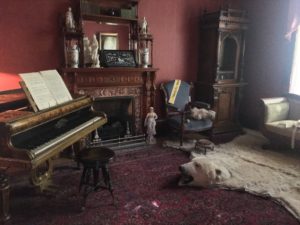
Therefore, through the lens of Victorian Era, it can be perceived that the function of items were used for more than aesthetic purposes- they were reflections of the owner’s conventionalized cultural beliefs and opinions- an outward show to society of one’s higher learning. Decorating with pelts or mounts of species was a way to bring the chaos and worldliness of nature into the domestic sphere by containing it within a civilized art form. In fact, it is rare to find photos of Victorian Era parlours without some sort of animal skins used as an accent rug within the room[ii]. This can be seen in the Brown’s own home, as a polar bear rug is proudly displayed in their parlour.
The collecting and displaying of natural specimens- fossils, minerals, and animals- during this time period, was much more about the palpable connection to natural history than anything else[iii].
The pursuit of collecting was held in high esteem at the time. It was thought that the illustration of such lofty pursuits elevated the owner in the eyes of contemporary society. In this sense, formal parlours function as private museums, comprising of a collection, with the sole purpose of impressing and wowing the guests of said family home[iv]. The display and subsequent social consumption of specimens from the natural world was not only reflective of a person’s brains, but their brawn as well. The hunting and killing of animals as a sport has always been popular with the human race since the days we stopped hunting out of necessity. Contemporary onlookers viewed hunting trophies as a symbol of a man’s accomplishments. His masculine traits were highlighted through his ownership and display of snarling, formidable beasts throughout the house, reflecting the glory of the hunter in the ferocity of the natural order[v]. Margaret was known to have gone hunting with Larry on occasion. She did this more out of a mo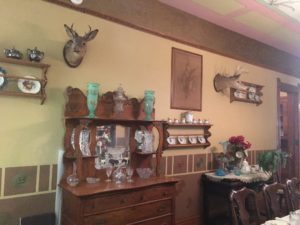 therly affection, than for the sport of it, wanting to spend quality time with her son. So although the Browns hunted, the animals scattered decoratively around the house are not trophies from these hunting excursions. Thus these pelts and busts in the family home should be viewed in the loftier sense of collecting- a vehicle for the reflection on the natural world and the projection of gentility, socially strive for at the time.
therly affection, than for the sport of it, wanting to spend quality time with her son. So although the Browns hunted, the animals scattered decoratively around the house are not trophies from these hunting excursions. Thus these pelts and busts in the family home should be viewed in the loftier sense of collecting- a vehicle for the reflection on the natural world and the projection of gentility, socially strive for at the time.
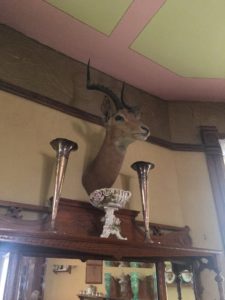
Margaret Brown’s contemporaries viewed nature and the natural world around them as mysterious new sphere for thought and investigation. In 1903, Martin Schütze wrote that naturalism is
‘…an important element in every great outburst of vital energy in art, literature, philosophy, and and social and political reconstruction…It rose, at the end of the eighteenth century, as a new sap into the tree of mankind which had been drained by an age of rationalism, bursting into the flowerage of Goethe and the literature and art of the nineteenth century in England, France, and Germany, and the countries influenced by these.’[i]
It was during the 19th century that taxidermy as a science and art form, would reach its’ peak. The Victorian Era burst forth as an age of scientific exploration and discovery, focusing on bringing the natural world into the civilized sphere, propelling taxidermy onto the scene as an all consuming fad. Even Charles Darwin, a highly respected scientist, hired out tutors in taxidermy; otherwise he would never have received, let alone have qualified for, the naturalist position aboard the HMS Beagle[vii].
The philosophy and science of Naturalism was of a great interest to society at the time. The Victorian Naturalists was a bimonthly scientific journal that started in the 1880s, covering all range of natural history, and is still being published today. As interest in the natural world began to grow, so too did the field of taxidermy. The 1800s ushered in a grand era of scientific field expeditions. Instead of relying on donations from private collectors, museums began to accumulate their own collection of mounted specimens by sending hired teams of explorers, naturalists and taxidermists to the far corners of the world[viii]. Scientific exploration and discovery of the natural world would become the driving force behind the rise of taxidermy. One particular Coloradan highlights the newfound growth in this scientific art form.
Martha Maxwell, also known as the Colorado Huntress, was a naturalist and taxidermist in Victorian Era United States. Born in Pennsylvania in July of 1831, Martha had a lifelong relationship with the natural world. She had no formal training in the art of taxidermy, and had only spent one year in higher learning, having been enrolled in Oberlin’s Young Ladies’ Preparatory Department before financial trouble cut her time short. She worked as a teacher before meeting and marrying James A. Maxwell in March of 1854. A short while later; an opportunity arose for Martha in the form of Professor E.F. Hobart. The principle of the Baraboo Collegiate Institute where Martha’s sisters went, proposed the creation of a Department of Zoology at the school, complete with a collection of mounted birds and mammals. Martha’s sisters’ proposed her name to Hobart because of her previous amateur attempt at taxidermy a year prior. For two years, she helped create a score of creatures for the collection, developing her skills in this new form of art that would shape the rest of her life. In the beginning, she relied on her male family members to bring her specimens to use. Martha soon realized she would have to be the one to collect more birds and mammals if she were to truly feed her aspirations. She obtained her own gun, practicing until she was a proficient shot[ix].
In 1868 Martha had her first public entry in the third annual Colorado Agricultural Society, presenting an array of creatures, arranged in a naturalistic setting. The judges awarded her fifty dollars and a diploma, the highest award Martha could have received. By 1870 she was gaining a reputation as a good taxidermist, mounting specimens for her own enjoyment, as well as for others. By the end of the year, the Maxwell family fell on hard times, forcing Martha to sell her exuberant collection to feed her family[x]. Although, developing into a lofty pursuit, taxidermy could not be considered a financially stable career.
Martha’s love of natural history and taxidermy continued to grow through the years. She wanted to share her talent with the nation, as her ever-increasing collection developed into a scientifically classed collection of specimens seen throughout the American landscape. Her love for the birds and mammals she immortalized in tableaux fuelled her aspirations to construct a space in which the public could come and observe Martha’s scientific pursuit. Striking up a friendship with Spencer Baird, employee at the Smithsonian Institution, Martha was able to obtain scientific textbooks on natural history that would further her knowledge in the field. In return for Baird’s connections, she added to the museum’s natural collection[xi].
Martha’s opening of the Rocky Mountain Museum in the summer of 1874 in Boulder, Colorado was met with critical acclaim. She aimed to develop a museum that was as entertaining as it was educational. Her exotic collection, displayed in dramatic habitual categories, appealed to the public’s interest, while scientists were awed by the scope and variety of the specimens it incorporated. Unfortunately the popular success of the Museum did not equate to financial success. The Boulder population was not large enough to support Martha’s venture, thus forcing her to move to Denver to reach a wider audience. The Rocky Mountain Museum opened a second time, this time in a building located on Lawrence Street. Again, the museum was met with critical success, and again, it ended in financial loss; unable to support itself, Martha had to close the museum in February of 1875, operating, in total, for less than a year[xii].
Although Martha’s attempt at a museum ultimately failed, the praise and publicity garnered from the endeavour, paved way for a new venture in taxidermy. She was invited to partake in the Colorado exhibit at the Philadelphia Centennial Exposition of 1876. It was here that Martha would reach the height of her acclaim. Throngs of visitors lined up daily to catch a glimpse of Martha’s naturalistic display of a vast array of creatures from the animal kingdom. A mountainous landscape, complete with trees and boulders, was erected within one of the Exposition buildings. She filled her tableaux with an array of animals, placed throughout to mimic the different elevation habitats. Running water was incorporated into the scene as a trickling stream filled with fish and half submerged mammals. The ‘river’ descended into a plains landscape with appropriate species to match[xiii]. Martha had truly taken the unbound natural world and transformed it into a civilized rendering of science and art to be consumed as entertainment and education.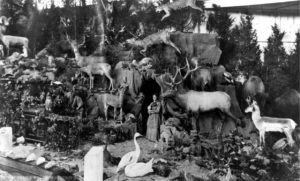
Her exhibit garnered a great amount of press; Martha was interviewed for a myriad of American newspapers and coined the Colorado Huntress. Viewers found it hard to marry the particularly masculine traits of the exposition display with the five-foot, 120-pound, feminine looking woman who shot and mounted them. Martha was apprehensive about the title ‘huntress’, and the images it would invoke, because she wanted to be seen first and foremost as a serious naturalist. Martha believed it was better to kill an animal and immortalize it in all its glory rather than to kill it for food.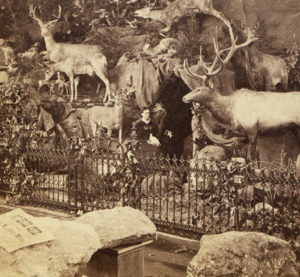
Although the most well circulated pictures of Martha were ones where she is in full hunting costume carrying a gun, she was more interested in the scientific and educational pursuit of taxidermy[xiv]. Hunting was only a means to an end for her- a stark contrast when held against the backdrop of the domestic sphere that viewed hunting trophies as strictly masculine.
Martha Maxwell passed away from ill health at the age of 49, in May of 1881. Her contributions as a field naturalist can still be felt today. Prior to Martha, lifelike exhibits- accurately depicted specimens rendered in their natural habits- were a wholly new way of presenting naturalism to the world, one that museums would utilize to its fullest in times to come[xv]. Martha’s life long love of naturalism, combined with the growing interest in the field during her lifetime, brought the scientific art form of taxidermy to the forefront of Colorado interest. The interest her Rocky Mountain Museum displays drummed up, gave her a platform to exhibit her work on a wider stage- the Philadelphia Centennial Exposition of 1876. Martha’s life, when held in juxtaposition with the Victorian trend of naturalistic decorating, it could be argued that her critical success at the Exposition went hand in hand with the newfound fascination of the natural world.
After the height of taxidermy in Victorian Era, the scientific art form that captured America’s attention soon fell to the wayside. The acclaim and interest taxidermists drummed up in the 1800s, with their fairs, expeditions and collections, dissipated with the turn of the century. By the mid 1900s, anatomically correct, majestic animals were no longer the norm when it came to mounting specimens. Instead, the human eye was met with sensationalized, crude renderings of still life[xvi]. This lack of reverence in a once scientific art form is apparent in modern day from the vast quantities of terrible taxidermy you can find online.
It is within the framework of the burgeoning appreciation of naturalism in all its forms at the time, combined with the socially constructed views that Victorian Era decorating perpetuated, that we can accurately view and appreciate the Brown’s specimens. Overall Victorian society understood the underlying importance of objects as symbolic cultural philosophies, tangible evidence of the owner’s worldly convictions, meant for the consumption of their piers. Combining itself with the favoured past time of collecting, Victorian naturalism became a reflection of one’s pursuit into the field of science and art.
Written by Hannah Maiorano, Hill Education Associate
Sources:
Benson, Maxine. Martha Maxwell: Rocky Mountain Naturalist. University of Nebraska Press, Lincoln and London. 1986
Briggs, Asa. Victorian Things. University of Chicago Press. Chicago, 1988.
Caskey Winkler, Gail and Roger W. Moss. Victorian Interior Decoration: American Interiors 1830-1900. Henry Holt and Company Inc. New York, 1986.
Ed. Foy, Jessica H. and Thomas J. Schlereth. American Home Life 1880-1930: A Social History of Spaces and Services. University of Tennessee Press, Knoxville, 1992.
Grier, Katherine C., Culture and Comfort: Parlour Making and Middle Class Identity 1850-1930. Smithsonian Institution Press, 1988.
Milgrom, Melissa. Still Life: Adventures in Taxidermy. Houghton Mifflin Harcourt, Boston and New York. 2010.
Schütze, Martin. The Services of Naturalism to Life and Literature. The Sewanee Review, Vol. 11, No. 4 (Oct., 1903), pp. 425-443 Published by: The Johns Hopkins University Press Stable URL: http://www.jstor.org/stable/27530580 – accessed July 26th 2017
[i] 50-53, American Home Life 1880-1930
[ii] 204, Victorian Interior Decoration
[iii] 58, American Home Life 1880-1930
[iv] 47, Victorian Things
[v] 36, American Home Life
[vi] 425, The Services of Naturalism to Life and Literature by Martin Schütze
[vii] 7, Still life
[viii] 77, Still life
[ix] 5-79, Martha Maxwell
[x] 82-89, Martha Maxwell
[xi] 96-103, Martha Maxwell
[xii] 109-114, Martha Maxwell
[xiii] 116-132, Martha Maxwell
[xiv] 134-142, Martha Maxwell
[xv] 190-194, Martha Maxwell
[xvi] 47, Still Life

